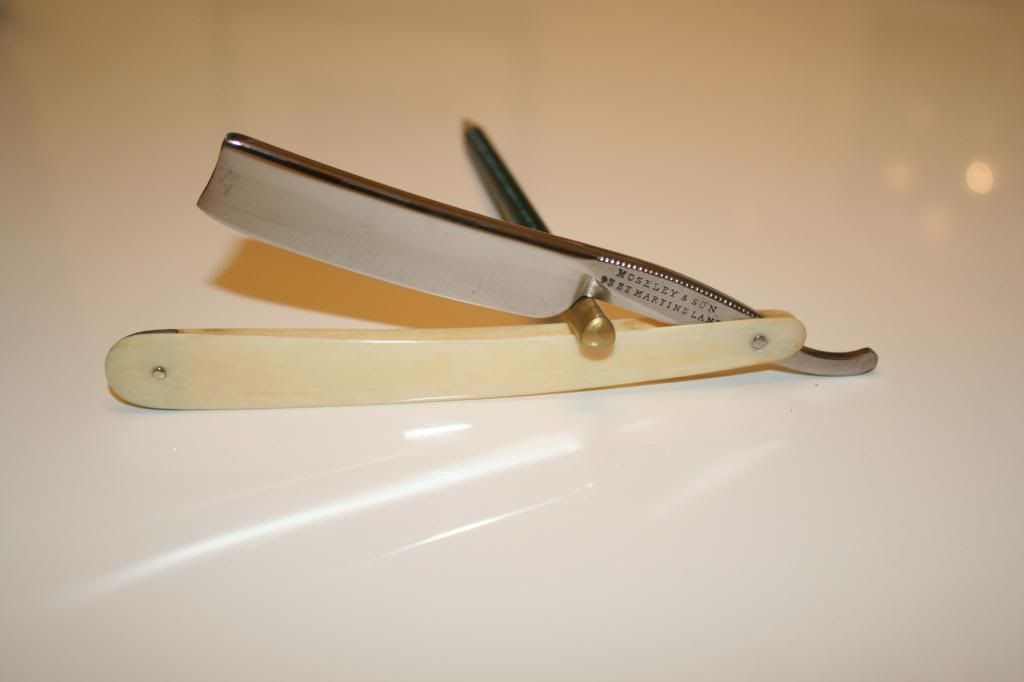Results 11 to 15 of 15
Thread: The smell of an old razor
-
06-27-2013, 07:33 PM #11

Apologies for not getting back sooner with some pictures - when I took a closer look (with my glasses on) I noticed that someone had tried to clean the blade with a low grit abrasive which had scored the bevel and edge. I ended up having to unpin and re-polish the blade, breadknife the edge and then re-hone. This is what it looks like now.



-
06-27-2013, 07:43 PM #12Senior Member


- Join Date
- Jan 2011
- Location
- Roseville,Kali
- Posts
- 10,432
Thanked: 2027
Very Nice,You mention how thin the scales are.Memeber sent me a razor a couple mos.back to make a replacement Ivory scale for one side that was cracked They were .050 thick,Like paper and almost transparent,That was an un-pinning and pinning job from hell.
-
06-28-2013, 06:05 AM #13

You should smell late 1800's bakelite or celluloid, you can actually smell the crude oil sometimes. lol
-
06-28-2013, 10:21 AM #14

You will notice that I used a small washer when re-pinning - I didn't want to risk cracking the pivot area. However, even though I tried to keep the peened head as small as possible it ended up being noticeably bigger than the original. I guess this is the trade off.
I sometimes wonder if there was a special method used for pinning ivory without washers as the risk of cracking just seem to be too great using the conventional method.
-
06-28-2013, 10:31 AM #15Senior Member



- Join Date
- Apr 2008
- Location
- Essex, UK
- Posts
- 3,816
Thanked: 3164
Cellulose certainly does smell - it has a few distinct odours, but bakelite is usually odourless or has only a slight smell, unless it is heated when it smells like burnt fish skin! It is due to the carbolic acid (phenol) in the product and many call it a 'hot electrical' smell. You may be thinking of hardened (vulcanized) rubber, which was used for scales - it smells if rubbed, but usually of rubber or rubber/sulphur.
Bakelite was researched into in the early 1900s - a license was obtained by Leo Baekland (who was rich from having invented the gorgeous Velox b&w photographic paper, sold to Kodak - a contact-printing paper with a luxurious surface: velvet, velvet lustre - simply beautiful) in 1906 but the commercial product was not refined until 1909. It was obtained by adding a filler (asbestos!) to phenol (aka carbolic acid, derived from coal tar) and formaldehyde (a preservative with a very irritating and harmful odour - it is classed by some as a carcinogen and is one of the main contributing factors to 'sick building' syndrome - the panels in buildings in the UK of a certain age were treated with it). The asbestos kept the very brittle resin from breaking too easily. Nowadays cellulose is more likely to be used in the form of powdered wood ('wood flour').
Celluloid is even further removed from crude oil. It goes back to the 1860s and is formed by nitrating cotton (steeping it in concentrated nitric and sulphuric acid to form the highly explosive 'gun cotton'), washing it and dissolving it (cotton is mainly cellulose) in ether, then adding coloring agents and fillers (asbestos was used here too, as well as other fillers) and preservatives. One of the preservatives was camphor and this gives some (not all) celluloid a characteristic 'medecine' smell of mentolated camphor, soewhat like the old fashioned moth-ball smell. It has a couple of other distinctive smells too, usually a sign of the material decomposing (which gives rise to 'cell-rot' in the steel of razors). One is a vinegar smell - from celluloid acetate (used as 'safety' film in the early days of the motion picture industry - places holding large stocks of film would smell of vinegar (acetic acid) shortly before they spontaneously caught on fire); the other is a faintly acidic odour which may or may not be accompanied by the camphor smell - this is due to the release of acidic vapour other than acetic acid.
Regards,
Neil
-


 8Likes
8Likes LinkBack URL
LinkBack URL About LinkBacks
About LinkBacks






 Reply With Quote
Reply With Quote
